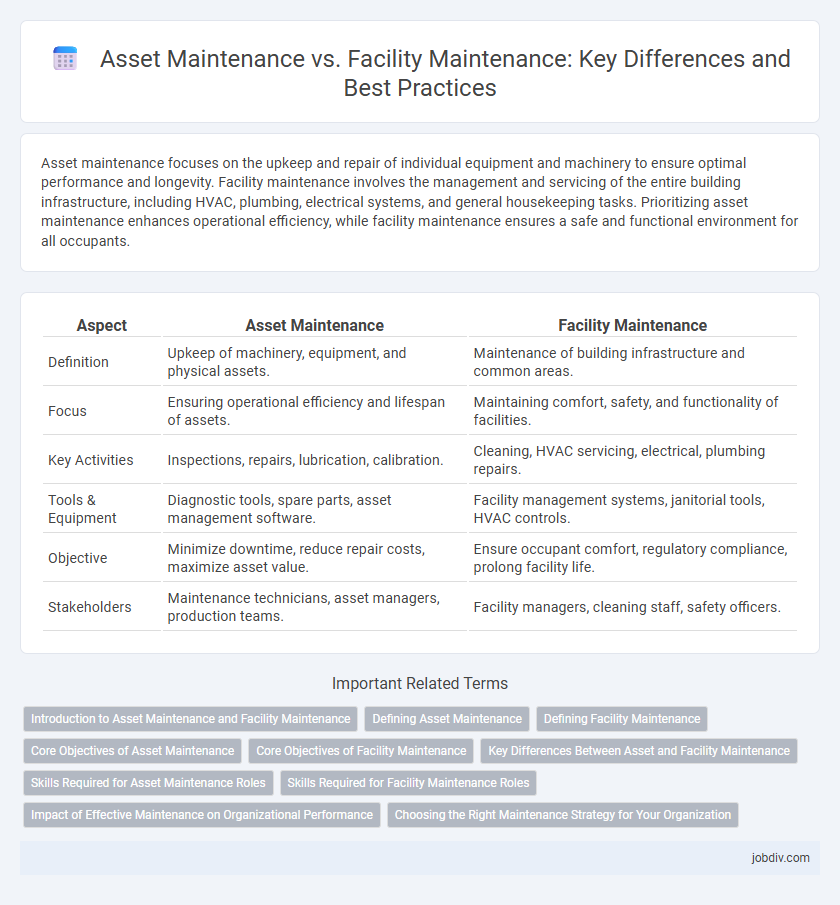Asset maintenance focuses on the upkeep and repair of individual equipment and machinery to ensure optimal performance and longevity. Facility maintenance involves the management and servicing of the entire building infrastructure, including HVAC, plumbing, electrical systems, and general housekeeping tasks. Prioritizing asset maintenance enhances operational efficiency, while facility maintenance ensures a safe and functional environment for all occupants.
Table of Comparison
| Aspect | Asset Maintenance | Facility Maintenance |
|---|---|---|
| Definition | Upkeep of machinery, equipment, and physical assets. | Maintenance of building infrastructure and common areas. |
| Focus | Ensuring operational efficiency and lifespan of assets. | Maintaining comfort, safety, and functionality of facilities. |
| Key Activities | Inspections, repairs, lubrication, calibration. | Cleaning, HVAC servicing, electrical, plumbing repairs. |
| Tools & Equipment | Diagnostic tools, spare parts, asset management software. | Facility management systems, janitorial tools, HVAC controls. |
| Objective | Minimize downtime, reduce repair costs, maximize asset value. | Ensure occupant comfort, regulatory compliance, prolong facility life. |
| Stakeholders | Maintenance technicians, asset managers, production teams. | Facility managers, cleaning staff, safety officers. |
Introduction to Asset Maintenance and Facility Maintenance
Asset maintenance involves the proactive management, repair, and servicing of machinery, equipment, and infrastructure to ensure optimal performance and longevity. Facility maintenance encompasses the upkeep of physical buildings, including HVAC systems, electrical wiring, and structural components to maintain a safe and functional environment. Both asset and facility maintenance prioritize reducing downtime, enhancing operational efficiency, and extending the lifespan of critical resources within an organization.
Defining Asset Maintenance
Asset maintenance involves the systematic care, repair, and upkeep of physical equipment and machinery to ensure optimal performance and extend their operational lifespan. It includes preventive, predictive, and corrective maintenance strategies tailored to specific assets, such as HVAC systems, production machines, or vehicles. This type of maintenance focuses on preserving the functionality and reliability of individual assets rather than the overall building infrastructure.
Defining Facility Maintenance
Facility maintenance refers to the comprehensive upkeep and management of building systems, structures, and environments to ensure safety, functionality, and efficiency. It includes tasks such as HVAC servicing, electrical system repairs, plumbing maintenance, and cleaning operations, all aimed at preserving the physical condition and operational integrity of the facility. Differing from asset maintenance, which focuses specifically on individual equipment or machinery, facility maintenance encompasses the broader scope of infrastructure and amenities within a property.
Core Objectives of Asset Maintenance
Asset maintenance centers on preserving the operational efficiency and longevity of individual machines, equipment, and critical production tools, targeting tasks like inspections, repairs, and predictive upkeep to minimize downtime and maximize performance. Core objectives include reducing unexpected breakdowns, optimizing asset lifecycle cost, and ensuring compliance with safety and regulatory standards. Facility maintenance, in contrast, involves the upkeep of the entire physical environment, including infrastructure, HVAC systems, and common areas, focusing on creating safe and functional spaces rather than directly maintaining production assets.
Core Objectives of Facility Maintenance
Facility maintenance centers on preserving building functionality, safety, and compliance with regulatory standards, ensuring an optimal environment for occupants and operations. Core objectives include routine inspections, preventive repairs, and system upgrades to prevent downtime and prolong asset lifespan. Unlike general asset maintenance, which targets individual equipment performance, facility maintenance integrates structural, electrical, HVAC, and safety system management for holistic site reliability.
Key Differences Between Asset and Facility Maintenance
Asset maintenance focuses on the upkeep, repair, and optimization of individual equipment or machinery to ensure operational efficiency and longevity. Facility maintenance involves managing the overall building infrastructure, including HVAC, electrical systems, and structural components, to provide a safe and functional environment. The key differences lie in asset maintenance targeting specific operational units, while facility maintenance addresses broader building systems and infrastructure.
Skills Required for Asset Maintenance Roles
Asset maintenance roles demand specialized technical skills such as equipment diagnostics, calibration, and predictive maintenance techniques to ensure optimal performance and reduce downtime. Proficiency in vibration analysis, thermography, and computerized maintenance management systems (CMMS) is essential for effective asset condition monitoring. Strong problem-solving abilities and knowledge of mechanical, electrical, and software systems differentiate asset maintenance experts from broader facility maintenance personnel.
Skills Required for Facility Maintenance Roles
Facility maintenance roles require a diverse skill set, including proficiency in HVAC systems, electrical repairs, plumbing, and safety compliance to ensure operational efficiency. Technicians must possess problem-solving skills and the ability to perform preventive maintenance to minimize downtime and extend equipment lifespan. Knowledge of building automation systems and regulatory standards further enhances the effectiveness of facility maintenance teams.
Impact of Effective Maintenance on Organizational Performance
Effective asset maintenance ensures the reliability and longevity of critical equipment, minimizing downtime and repair costs that directly enhance organizational productivity. Facility maintenance supports a safe and efficient work environment, improving employee satisfaction and reducing health-related absences. Together, optimized asset and facility maintenance strategies drive operational efficiency, cost savings, and overall organizational performance.
Choosing the Right Maintenance Strategy for Your Organization
Choosing the right maintenance strategy requires understanding the distinction between asset maintenance, which focuses on preserving individual equipment performance, and facility maintenance, which ensures the overall building's operational integrity. Asset maintenance strategies often include predictive and preventive approaches targeting machinery uptime and lifespan extension, while facility maintenance emphasizes regular inspections and repairs to maintain safety and compliance standards. Aligning maintenance practices with organizational goals, resource availability, and regulatory requirements maximizes operational efficiency and cost-effectiveness.
Asset Maintenance vs Facility Maintenance Infographic

 jobdiv.com
jobdiv.com